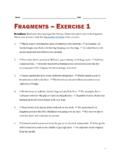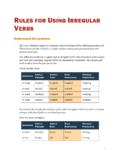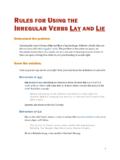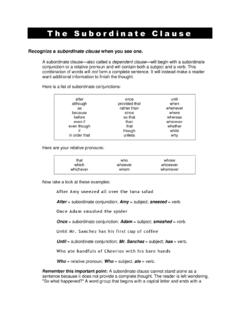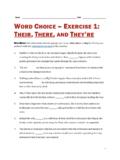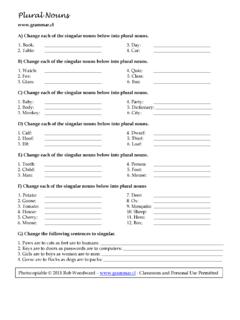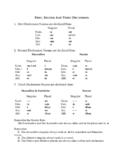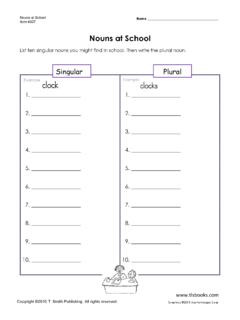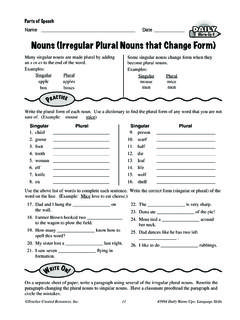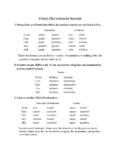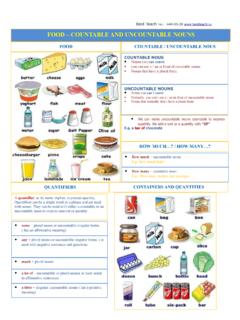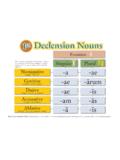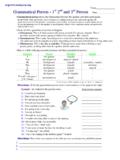Transcription of T he N oun
1 T h e N o u n Recognize a noun when you see one. George! Jupiter! Ice cream! Courage! Books! Bottles! Godzilla! All of these words are nouns, words that identify the whos, wheres, and whats in language. Nouns name people, places, and things. Read the sentence that follows: George and G odzilla w al ked to Antoni o's to order a l arge pep pero ni pi zza. George is a person. Antonio's is a place. Pizza is a thing. Godzilla likes to think he's a person, is as big as a place, but qualifies as another thing. Understand the functions that nouns provide in sentences. Nouns can function as subjects, direct objects, indirect objects, objects of prepositions, and subject complements.
2 Check out these examples: Godzilla or dere d a larg e pe pper on i p izza an d a te th e pi e i n a sin gle bi te. Godzilla = the subject for the verbs ordered and ate. Geor ge o ffere d Godzilla a te n-d oll ar loan to bu y a s ec on d pizza. Godzilla = the indirect object of offered; loan = the direct object of offered. Whi le e a tin g a piec e of p izza, Ge org e dri ppe d t om at o s auc e o nt o his shirt. Shirt = the object of the preposition onto. I n Godz il la's op in io n , Georg e i s a slob. Slob = subject complement of the linking verb is. Know the different classes of nouns. Nouns have different classes: proper and common, concrete and abstract, count and noncount, and collective.
3 Proper nouns name specific, one-of-a-kind items while common nouns identify the general varieties. Proper nouns always begin with capital letters; common nouns, on the other hand, only require capitalization if they start the sentence or are part of a title. Read these two versions: George and G odzilla di ne d a t Antonio's. George, Godzilla, Antonio's = proper nouns. A boy and hi s monster d ine d a t a pizza restaurant. Boy, monster, restaurant = common nouns. You classify concrete and abstract nouns by their ability to register on your five senses. If you can see, hear, smell, taste, or feel the item, it's a concrete noun . If, however, you cannot experience the item with any of your senses, it's abstract.
4 Here are two examples: Pizza is Go dzil la' s f avor it e fo od. Pizza = concrete because you can see, hear, smell, feel [though you get your fingers greasy], and thankfully taste it. Godz ill a n ever ti ps t he de li very bo y fro m Ant on io' s; politeness is no t o ne o f Go dzil la' s str ong po in ts. Politeness = abstract [you cannot see politeness, or hear, smell, taste, or touch the quality itself]. Many nouns can be singular or plural; these are count nouns. Noncount nouns, on the other hand, have only a singular form; to make them plural is illogical. Read the sentences that follow: Godz ill a a te thr ee pizzas, tw o de li very boys, a nd six park ed car s.
5 Pizzas, boys, and cars = count nouns. Godzilla didn't have to be such a pig; he could have eaten only one pizza, one delivery boy, and one car. Aft er ov eri ndu lg ing at An to ni o's, G odz ill a go t s ever e indigestion. Indigestion = noncount. You cannot write, "Godzilla got eleven indigestions." Collective nouns name groups. Although the group is a single unit, it has more than one member. Some examples are army, audience, board, cabinet, class, committee, company, corporation, council, department, faculty, family, firm, group, jury, majority, minority, navy, public, school, society, team, and troupe. Collective nouns are especially tricky when you are trying to make verbs and pronouns agree with them.
6 The reason is that collective nouns can be singular or plural, depending on the behavior of the members of the group. For example, if the members are acting as a unit everyone doing the same thing at the same time the collective noun is singular and requires singular verbs and pronouns. Read this example: Des pi te th e da ng er t o its n ew v an, th e S WAT t eam pursu es the pizza-e a tin g G odzi ll a t hrou gh th e s tree t s of M ia mi. In this sentence, the members of the collective noun team are acting in unison; each officer is engaged in the same activity at the same time. Thus, its, a singular pronoun, and pursues, a singular verb, are required. Now read the next example: Aft er ge t ti ng their bu tt s k ic ke d b y Go d zill a, t he t eam change in to t heir str ee t c lo the s a nd sob in t hei r c ars o n t he w ay ho me.
7 Here, the team members are acting individually. They are not putting on one giant set of street clothes that covers them all. They are not in unison pulling on their left socks first, then their right socks second. Instead, each member is dressing as he wishes, driving his own car to his own home. In cases like this, the collective noun is plural and requires plural pronouns [like their] and plural verbs [like change]. Keep in mind that a single noun can fall into more than one class. Here is an example: Godz ill a h as kn ow n f ive Georges in hi s l ife. Georges = proper, concrete, and count. 1997 - 2014 by Robin L. Simmons All Rights Reserved.
8
